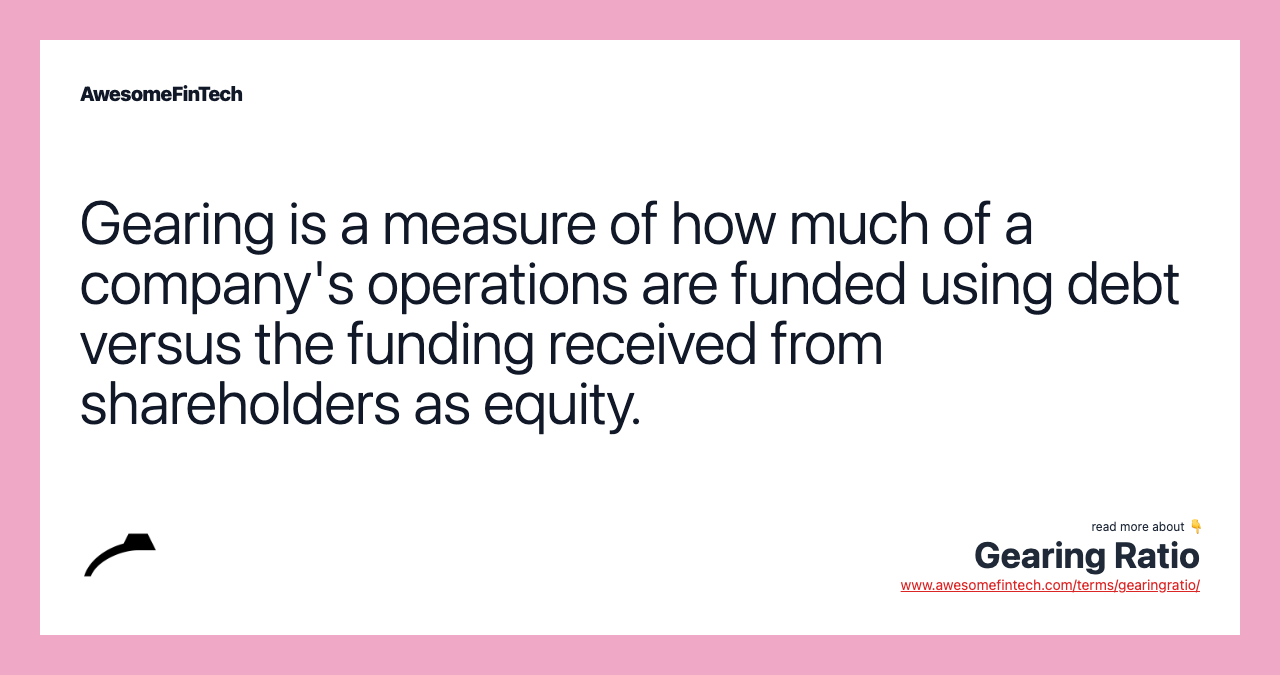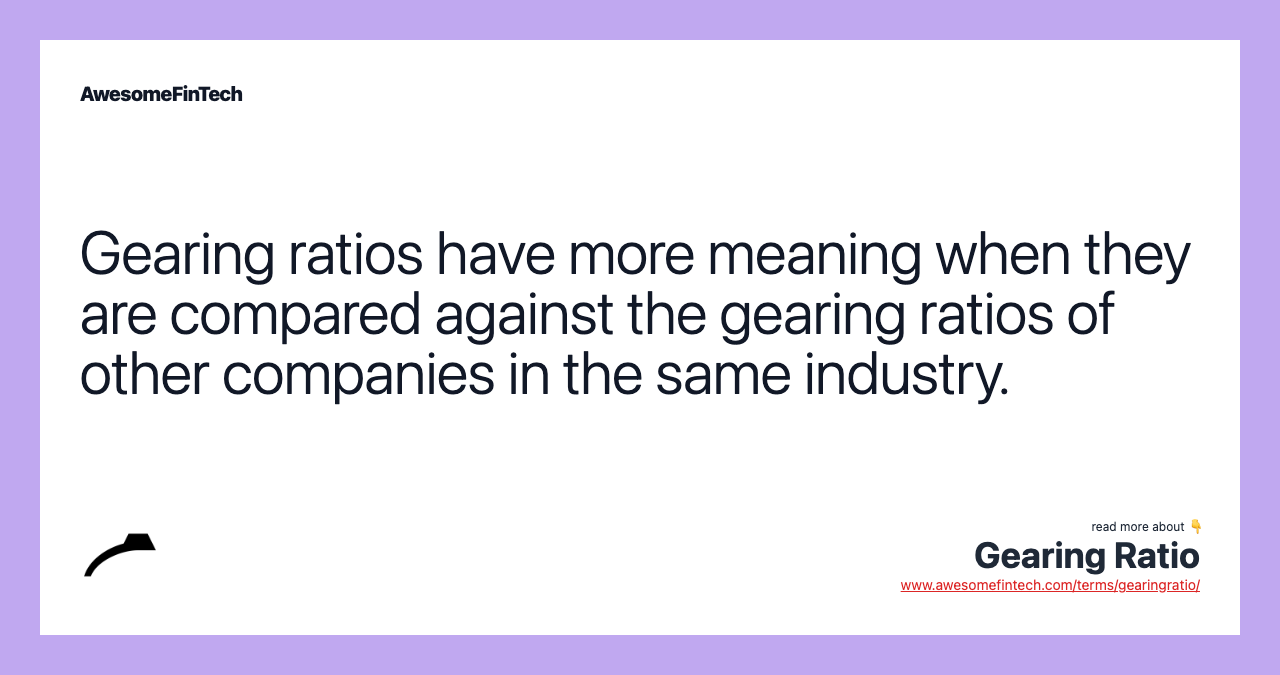Gearing Ratio
Gearing ratios are financial ratios that compare some form of owner's equity (or capital) to debt, or funds borrowed by the company. Gearing ratios have more meaning when they are compared against the gearing ratios of other companies in the same industry. The best known examples of gearing ratios include: Debt-to-Equity Ratio \= Total Debt Total Equity \\begin{aligned} &\\text{Debt-to-Equity Ratio} = \\frac { \\text{Total Debt} }{ \\text{Total Equity} } \\\\ \\end{aligned} Debt-to-Equity Ratio\=Total EquityTotal Debt Times Interest Earned\\= EBIT Total Interest \\begin{aligned} &\\text{Times Interest Earned\*} = \\frac { \\text{EBIT} }{ \\text{Total Interest} } \\\\ \\end{aligned} Times Interest Earned\*\=Total InterestEBIT Equity Ratio \= Equity Assets \\begin{aligned} &\\text{Equity Ratio} = \\frac { \\text{Equity} }{ \\text{Assets} } \\\\ \\end{aligned} Equity Ratio\=AssetsEquity Debt Ratio \= Total Debt Total Assets \\begin{aligned} &\\text{Debt Ratio} = \\frac { \\text{Total Debt} }{ \\text{Total Assets} } \\\\ \\end{aligned} Debt Ratio\=Total AssetsTotal Debt \times interest earned A higher gearing ratio indicates that a company has a higher degree of financial leverage and is more susceptible to downturns in the economy and the business cycle. Entities with a high gearing ratio have higher amounts of debt to service, while companies with lower gearing ratio calculations have more equity to rely on for financing. Instead, a company with a high gearing ratio has a riskier financing structure than a company with a lower gearing ratio. When the industry average ratio result is 0.8, and the competition's gearing ratio result is 0.9, a company with a 0.3 ratio is, comparatively, performing well in its industry.

What Is the Gearing Ratio?
Gearing ratios are financial ratios that compare some form of owner's equity (or capital) to debt, or funds borrowed by the company. Gearing is a measurement of the entity’s financial leverage, which demonstrates the degree to which a firm's activities are funded by shareholders' funds versus creditors' funds.
The gearing ratio is a measure of financial leverage that demonstrates the degree to which a firm's operations are funded by equity capital versus debt financing.



Understanding Gearing Ratios
The best known examples of gearing ratios include:
Debt-to-Equity Ratio = Total Debt Total Equity \begin{aligned} &\text{Debt-to-Equity Ratio} = \frac { \text{Total Debt} }{ \text{Total Equity} } \\ \end{aligned} Debt-to-Equity Ratio=Total EquityTotal Debt
Times Interest Earned* = EBIT Total Interest \begin{aligned} &\text{Times Interest Earned*} = \frac { \text{EBIT} }{ \text{Total Interest} } \\ \end{aligned} Times Interest Earned*=Total InterestEBIT
Equity Ratio = Equity Assets \begin{aligned} &\text{Equity Ratio} = \frac { \text{Equity} }{ \text{Assets} } \\ \end{aligned} Equity Ratio=AssetsEquity
Debt Ratio = Total Debt Total Assets \begin{aligned} &\text{Debt Ratio} = \frac { \text{Total Debt} }{ \text{Total Assets} } \\ \end{aligned} Debt Ratio=Total AssetsTotal Debt
* times interest earned
A higher gearing ratio indicates that a company has a higher degree of financial leverage and is more susceptible to downturns in the economy and the business cycle. This is because companies that have higher leverage have higher amounts of debt compared to shareholders' equity. Entities with a high gearing ratio have higher amounts of debt to service, while companies with lower gearing ratio calculations have more equity to rely on for financing.
Gearing ratios are useful for both internal and external parties. Financial institutions use gearing ratio calculations when deciding whether to issue loans. In addition, loan agreements may require companies to operate with specified guidelines regarding acceptable gearing ratio calculations. Alternatively, internal management uses gearing ratios to analyze future cash flows and leverage.
Interpreting Gearing Ratios
A high gearing ratio typically indicates a high degree of leverage, although this does not always indicate a company is in poor financial condition. Instead, a company with a high gearing ratio has a riskier financing structure than a company with a lower gearing ratio.
Regulated entities typically have higher gearing ratios as they can operate with higher levels of debt. In addition, companies in monopolistic situations often operate with higher gearing ratios as their strategic marketing position puts them at a lower risk of default. Finally, industries that use expensive fixed assets typically have higher gearing ratios, as these fixed assets are often financed with debt.
A firm's gearing ratio should be compared with the rations of other companies in the same industry.
Example of How to Use Gearing Ratios
Assume that a company has a debt ratio of 0.6. Although this figure alone provides some information as to the company’s financial structure, it is more meaningful to benchmark this figure against another company in the same industry.
For instance, assume the company's debt ratio last year was 0.3, the industry average is 0.8, and the company’s main competitor has a debt ratio of 0.9. More information is derived from the use of comparing gearing ratios to each other. When the industry average ratio result is 0.8, and the competition's gearing ratio result is 0.9, a company with a 0.3 ratio is, comparatively, performing well in its industry.
Related terms:
Business Cycle : How Is It Measured?
The business cycle depicts the increase and decrease in production output of goods and services in an economy. read more
Debt-to-Equity (D/E) Ratio & Formula
The debt-to-equity (D/E) ratio indicates how much debt a company is using to finance its assets relative to the value of shareholders’ equity. read more
Debt Ratio
The debt ratio is a fundamental analysis measure that looks at the extent of a company’s leverage. read more
Equity : Formula, Calculation, & Examples
Equity typically refers to shareholders' equity, which represents the residual value to shareholders after debts and liabilities have been settled. read more
Fixed Asset
A fixed asset is a long-term tangible asset that a firm owns and uses to produce income and is not expected to be used or sold within a year. read more
Gearing
Gearing refers to the ratio of a company's debt relative to its equity; if it's high, then a firm may be considered as highly geared (or leveraged). read more
Leverage : What Is Financial Leverage?
Leverage results from using borrowed capital as a source of funding when investing to expand a firm's asset base and generate returns on risk capital. read more
Leverage Ratio : Formula & Calculation
A leverage ratio is any one of several financial measurements that look at how much capital comes in the form of debt, or that assesses the ability of a company to meet financial obligations. read more
Long-Term Debt to Capitalization Ratio
The long-term debt to capitalization ratio, calculated by dividing long-term debt by available capital, shows the financial leverage of a firm. read more